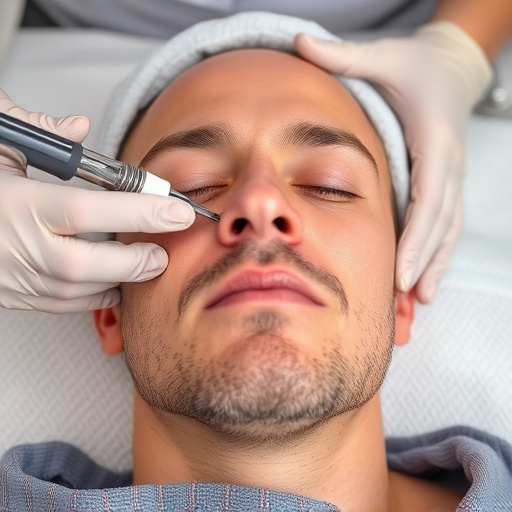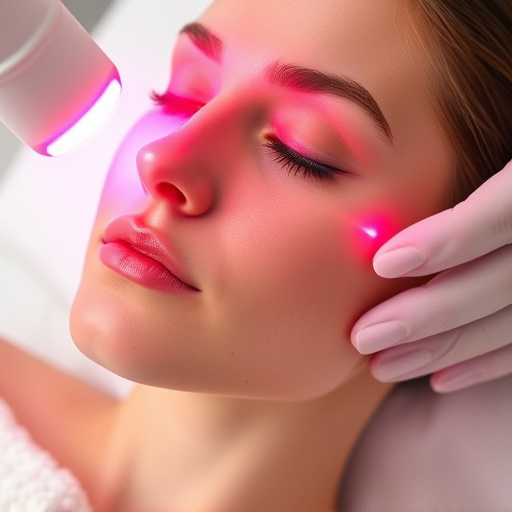Hyperpigmentation, caused by sun exposure, inflammation, hormones, and other factors, can be treated effectively with advanced skincare solutions. Scientific research has uncovered mechanisms behind hyperpigmentation, leading to development of targeted treatments like topical creams, serums, chemical peels, and products containing vitamin C, hydroquinone, retinoids, azelaic acid, and kojic acid. Personalized skincare routines incorporating these ingredients can improve skin brightening and achieve an even complexion.
“Uncover the science behind effective hyperpigmentation treatment products in this comprehensive guide. Hyperpigmentation, a common skin concern, arises from various causes, including sun damage, inflammation, and hormonal changes. Understanding these factors is key to developing targeted solutions. Explore how scientific research has unveiled powerful ingredients like Vitamin C, Hydroquinone, and Niacinamide, each with unique mechanisms to inhibit melanin production and even out skin tone. From cause to cure, this article delves into the science behind hyperpigmentation treatment for a radiant complexion.”
- Understanding Hyperpigmentation: Causes and Types
- The Role of Science in Developing Treatment Solutions
- Effective Ingredients and Their Mechanisms of Action
Understanding Hyperpigmentation: Causes and Types

Hyperpigmentation is a common skin concern characterized by discolored patches that appear darker than surrounding skin. It can be caused by various factors and manifests in several types. One of the most well-understood causes is sun exposure, where ultraviolet (UV) rays trigger melanocytes, the cells responsible for producing melanin, to overproduce pigment. This leads to conditions like solar hyperpigmentation, often seen as dark spots or uneven skin tone after prolonged sun exposure.
Another type is post-inflammatory hyperpigmentation, which occurs as a result of skin injuries or inflammation. Acne, wounds, and even certain skin conditions can trigger melanin production in the affected area, leading to discoloration. Additionally, hormonal changes during pregnancy or menstruation can cause melasma, a form of hyperpigmentation often characterized by light brown patches on the face. Understanding these causes is crucial when exploring effective hyperpigmentation treatment products, including those focused on pore refinement and non-surgical treatments, as well as skin brightening solutions.
The Role of Science in Developing Treatment Solutions

The development of hyperpigmentation treatment products is a testament to the power of science in addressing skin concerns. With advancements in dermatological research, scientists have been able to uncover the complex mechanisms behind hyperpigmentation, enabling them to create highly effective treatment solutions. Understanding the role of melanin production, melanosomes, and their interaction with various environmental factors has led to innovative approaches such as topical creams, serums, and even procedures like chemical peels.
These scientific breakthroughs have not only enhanced our knowledge of skin physiology but also resulted in a diverse range of facial treatments targeting hyperpigmentation. From targeted acne treatments that mitigate post-inflammatory dark spots to clinical chemical peels that meticulously remove the top layer of skin, these methods work synergistically to brighten and even out skin tone. This continuous pursuit of scientific excellence ensures that individuals seeking hyperpigmentation treatment have access to safe, efficient, and cutting-edge options tailored to their specific needs.
Effective Ingredients and Their Mechanisms of Action

Hyperpigmentation treatment products often boast a range of active ingredients that target melanin production and distribution. Key players in effective hyperpigmentation treatments include vitamin C, hydroquinone, retinoids, azelaic acid, and kojic acid. These ingredients work through various mechanisms to inhibit tyrosinase, the enzyme responsible for melanin synthesis, thereby reducing the appearance of dark spots and uneven skin tone.
Skin rejuvenation is not just about removing hyperpigmentation; it’s also about enhancing overall skin brightening. Personalized skincare routines that incorporate targeted hyperpigmentation treatment products can help restore a more even and radiant complexion. By understanding the unique mechanisms of these ingredients, consumers can make informed choices to achieve optimal results in their journey towards a brighter, more uniform skin tone.
Hyperpigmentation treatment has evolved significantly, driven by scientific advancements that offer targeted solutions. By understanding the causes and types of hyperpigmentation, scientists have identified key ingredients like hydroquinone, retinoids, and niacinamide, which work by inhibiting melanin production or enhancing exfoliation. Ongoing research continues to refine these treatments, providing hope for achieving a more even skin tone. Incorporating evidence-based products into skincare routines can effectively manage and reduce the appearance of hyperpigmentation, addressing a common concern for many.














